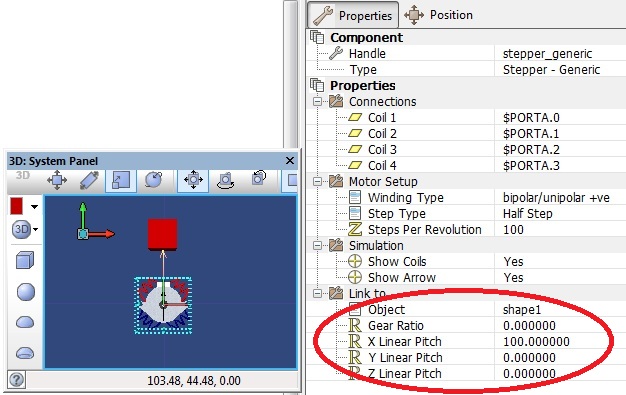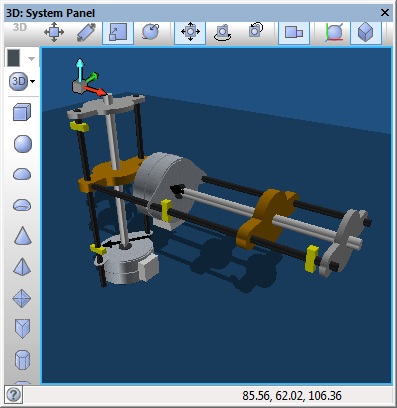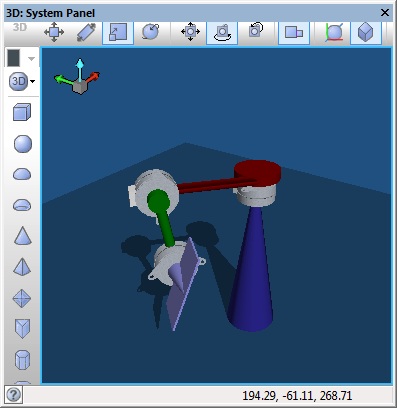Difference between revisions of "Component: Stepper Motor (Generic) ()"
| Line 15: | Line 15: | ||
A generic stepper motor model. Includes a visual simulation showing the activaton pattern of the coils. Make another object move along with the stepper shaft using the 'Target' property. The target object can rotate with the stepper shaft with a given gearing ratio, or be moved linearly according to a given lead screw pitch. | A generic stepper motor model. Includes a visual simulation showing the activaton pattern of the coils. Make another object move along with the stepper shaft using the 'Target' property. The target object can rotate with the stepper shaft with a given gearing ratio, or be moved linearly according to a given lead screw pitch. | ||
| − | ==Component | + | ==Component Source Code== |
| − | + | Please click here for the component source code: [https://www.flowcode.co.uk/wikicopy/componentsource/FC_Comp_Source_Stepper_Motor_Generic.fcfx FC_Comp_Source_Stepper_Motor_Generic.fcfx] | |
==Detailed description== | ==Detailed description== | ||
| + | |||
| + | |||
| Line 34: | Line 36: | ||
==Examples== | ==Examples== | ||
| + | |||
| + | |||
| Line 84: | Line 88: | ||
|- | |- | ||
|- | |- | ||
| − | + | | width="10%" align="center" style="background-color:#EAE1EA;" | [[File:Fc9-conn-icon.png]] | |
| − | + | | width="90%" style="background-color:#EAE1EA; color:#4B008D;" | Connections | |
| − | |||
| − | |||
| − | |||
| − | |||
| − | |||
| − | |||
| − | |||
| − | |||
| − | |||
| − | |||
| − | |||
| − | |||
| − | |||
| − | |||
| − | |||
| − | |||
| − | |||
| − | |||
| − | |||
| − | |||
| − | |||
| − | |||
| − | |||
| − | |||
| − | |||
| − | |||
| − | |||
| − | |||
| − | |||
| − | |||
| − | |||
| − | |||
| − | |||
| − | |||
| − | |||
| − | |||
| − | |||
| − | |||
| − | | width="10%" align="center" style="background-color:# | ||
| − | | width="90%" style="background-color:# | ||
|- | |- | ||
|- | |- | ||
| Line 153: | Line 117: | ||
| colspan="2" | Chip pin to which the fourth motor coil is connected. | | colspan="2" | Chip pin to which the fourth motor coil is connected. | ||
|- | |- | ||
| − | | width="10%" align="center" style="background-color:# | + | | width="10%" align="center" style="background-color:#EAE1EA;" | [[File:Fc9-conn-icon.png]] |
| − | | width="90%" style="background-color:# | + | | width="90%" style="background-color:#EAE1EA; color:#4B008D;" | Motor Setup |
| + | |- | ||
| + | |- | ||
| + | | width="10%" align="center" | [[File:Fc9-type-16-icon.png]] | ||
| + | | width="90%" | Winding Type | ||
| + | |- | ||
| + | | colspan="2" | The polarity settings of the motor windings. Refer to the data-sheet for your chosen hardware to determine this value. | ||
| + | |- | ||
| + | | width="10%" align="center" | [[File:Fc9-type-16-icon.png]] | ||
| + | | width="90%" | Step Type | ||
| + | |- | ||
| + | | colspan="2" | Trade accuracy against torque by changing the type of stepping. Refer to the data-sheet for your chosen hardware to determine which modes your device supports. | ||
| + | |- | ||
| + | | width="10%" align="center" | [[File:Fc9-type-14-icon.png]] | ||
| + | | width="90%" | Steps Per Revolution | ||
| + | |- | ||
| + | | colspan="2" | The number of steps it takes for the motor shaft to turn a full circle (360 degrees). Refer to the data-sheet for your chosen hardware to determine this value. | ||
| + | |- | ||
| + | | width="10%" align="center" style="background-color:#EAE1EA;" | [[File:Fc9-conn-icon.png]] | ||
| + | | width="90%" style="background-color:#EAE1EA; color:#4B008D;" | Simulation | ||
|- | |- | ||
|- | |- | ||
| Line 171: | Line 154: | ||
|- | |- | ||
| colspan="2" | Show an arrow connected to the motor shaft to make it easier to see the position. | | colspan="2" | Show an arrow connected to the motor shaft to make it easier to see the position. | ||
| + | |- | ||
| + | | width="10%" align="center" style="background-color:#EAE1EA;" | [[File:Fc9-conn-icon.png]] | ||
| + | | width="90%" style="background-color:#EAE1EA; color:#4B008D;" | Link to... | ||
| + | |- | ||
| + | |- | ||
| + | | width="10%" align="center" | [[File:Fc9-type-17-icon.png]] | ||
| + | | width="90%" | Object | ||
| + | |- | ||
| + | | colspan="2" | Choose an object here to be linked to the motor. When the motor moves, this object will also be moved according to the settings made in the other properties below. To move multiple objects, first make them into a single group, then set the group as the target. | ||
| + | |- | ||
| + | | width="10%" align="center" | [[File:Fc9-type-15-icon.png]] | ||
| + | | width="90%" | Gear Ratio | ||
| + | |- | ||
| + | | colspan="2" | Set a non-zero value here to make the target object rotate whenever the motor spins. The target will revolve around the same axis as the motor's own 'Moving Part' (e.g. drive shaft). A value of 1.00 make the target spin at the same speed as the motor. Choose other values to set the ratio of a 'virtual gearbox' to change the speed of the target's movement. | ||
| + | |- | ||
| + | | width="10%" align="center" | [[File:Fc9-type-15-icon.png]] | ||
| + | | width="90%" | X Linear Pitch | ||
| + | |- | ||
| + | | colspan="2" | Set this to a non-zero value to move the target object linearly along its X-Axis whenever the motor spins. The value is the distance to move (world units) per complete rotation of the motor shaft - i.e. it simulates a typical linear drive that uses a lead-screw, with the property value equal to the screw pitch. | ||
| + | |- | ||
| + | | width="10%" align="center" | [[File:Fc9-type-15-icon.png]] | ||
| + | | width="90%" | Y Linear Pitch | ||
| + | |- | ||
| + | | colspan="2" | Set this to a non-zero value to move the target object linearly along its Y-Axis whenever the motor spins. The value is the distance to move (world units) per complete rotation of the motor shaft - i.e. it simulates a typical linear drive that uses a lead-screw, with the property value equal to the screw pitch. | ||
| + | |- | ||
| + | | width="10%" align="center" | [[File:Fc9-type-15-icon.png]] | ||
| + | | width="90%" | Z Linear Pitch | ||
| + | |- | ||
| + | | colspan="2" | Set this to a non-zero value to move the target object linearly along its Z-Axis whenever the motor spins. The value is the distance to move (world units) per complete rotation of the motor shaft - i.e. it simulates a typical linear drive that uses a lead-screw, with the property value equal to the screw pitch. | ||
|} | |} | ||
Revision as of 17:51, 9 November 2022
| Author | Matrix Ltd |
| Version | 2.0 |
| Category |
Contents
Stepper Motor (Generic) component
A generic stepper motor model. Includes a visual simulation showing the activaton pattern of the coils. Make another object move along with the stepper shaft using the 'Target' property. The target object can rotate with the stepper shaft with a given gearing ratio, or be moved linearly according to a given lead screw pitch.
Component Source Code
Please click here for the component source code: FC_Comp_Source_Stepper_Motor_Generic.fcfx
Detailed description
No detailed description exists yet for this component
Examples
Attaching a primitive to a stepper motor
This example links a panel primitive to the output of the motor.
![]() Stepper Example 1
The linked object can be rotated or moved in a fixed direction by the motor.
Stepper Example 1
The linked object can be rotated or moved in a fixed direction by the motor.
Linear movement using a stepper motor
This example links two stepper motors together using linear type movements rather then rotational similar to a stepper attached to a lead screw.
![]() Stepper Example 2
The stepper is linked to the objects on the panel using properties and grouping.
Stepper Example 2
The stepper is linked to the objects on the panel using properties and grouping.
Creating a multi-axis actuator using stepper motors
This example links three stepper motors together using panel primitive objects and groups.
![]() Stepper Example 3
Here we can see the actuator arm in motion.
Stepper Example 3
Here we can see the actuator arm in motion.


